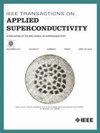Optimal Design and Analysis of a 14 T Actively Shielded MRI Superconducting Magnet for Medium-Sized Animals
IF 1.8
3区 物理与天体物理
Q3 ENGINEERING, ELECTRICAL & ELECTRONIC
引用次数: 0
Abstract
This article employs a hybrid optimization method combining two linear programming (LP) steps with one genetic algorithm (GA) step, referred to as 2LP-GA, to successfully design a 14 T/600 mm self-shielding superconducting magnet for medium-sized animal imaging. The magnetic field homogeneity within a spherical volume of 10 cm in diameter is 0.65 ppm. The magnet features a structure integrating a long solenoid with compensation coils and utilizes NbTi and Nb3Sn superconducting materials to reduce manufacturing costs. In addition, this article uses a calculation method for the mechanical properties of superconducting composite materials and applies the obtained parameters to finite element analysis, examining mechanical stresses during winding, cooling, and energization processes. The maximum hoop stress in the coil is 154 MPa. Finally, a quench protection system for the magnet is designed, combining quench detection circuits with active heating methods. Under worst-case quench scenarios, the maximum hotspot temperature and maximum voltage of the coil are limited to 113 K and 1688 V. The analysis also considers stress and stray field variations caused by asynchronous current decay during the quench process.中型动物用14t主动屏蔽MRI超导磁体的优化设计与分析
本文采用两步线性规划(LP)和一步遗传算法(GA)相结合的混合优化方法,即2LP-GA,成功设计了一种用于中型动物成像的14t / 600mm自屏蔽超导磁体。在直径为10 cm的球形体积内,磁场均匀性为0.65 ppm。该磁体采用长螺线管与补偿线圈相结合的结构,采用NbTi和Nb3Sn超导材料,降低了制造成本。此外,本文采用了超导复合材料力学性能的计算方法,并将所得参数应用于有限元分析,考察了缠绕、冷却和通电过程中的力学应力。线圈的最大环向应力为154兆帕。最后,设计了磁体失温保护系统,将失温检测电路与主动加热方法相结合。在最坏淬火情况下,线圈的最大热点温度和最大电压限制在113 K和1688 V。分析还考虑了淬火过程中异步电流衰减引起的应力和杂散场变化。
本文章由计算机程序翻译,如有差异,请以英文原文为准。
求助全文
约1分钟内获得全文
求助全文
来源期刊

IEEE Transactions on Applied Superconductivity
工程技术-工程:电子与电气
CiteScore
3.50
自引率
33.30%
发文量
650
审稿时长
2.3 months
期刊介绍:
IEEE Transactions on Applied Superconductivity (TAS) contains articles on the applications of superconductivity and other relevant technology. Electronic applications include analog and digital circuits employing thin films and active devices such as Josephson junctions. Large scale applications include magnets for power applications such as motors and generators, for magnetic resonance, for accelerators, and cable applications such as power transmission.
 求助内容:
求助内容: 应助结果提醒方式:
应助结果提醒方式:


